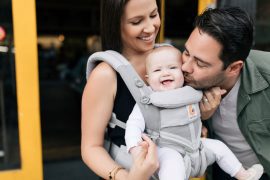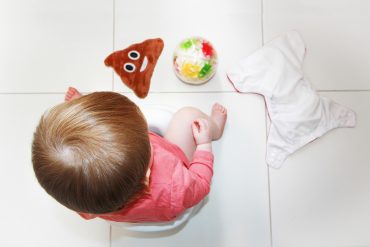Point 4: “They are difficult to use and uncomfortable, so are not worth spending money on.”
It is true that some baby slings and carriers look very complicated. They may feel overwhelming in the early weeks when parents are tired and it is harder to retain new information. Even with good instructions, many people find they learn better with someone else’s support, so do find your local sling library who can help you make sense of it. There are also many very simple options available; a bit of preparation and research will help, as well as going to a sling library for ideas and practice before you buy anything. Renting one for a week or two to check it works and feels good will avoid the need to buy several that aren’t comfortable.
Some cheaper carriers that are sold by supermarkets or on online giants like eBay or Amazon are often poor copies of those that are have been designed with care and thought.
They may have “weight limits” to 15kg but parents often find them uncomfortable long before this, due to the less-than-ideal design that doesn’t distribute weight well and baby can feel as if they are “hanging off the shoulders” and very heavy.
Sometimes, parents wonder about using a baby carrier to keep their children close, which is fantastic; a brilliant thing to consider. They may not be aware of sling library resources, and may opt to try out a cheaper carrier “to see if I like it”… to help them decide if it is worth investing in a more expensive one later.
Unfortunately, as these cheaper carriers don’t focus as much on baby safety or comfort, or parent comfort and ease of use, they’re not the greatest introduction to the world of happy and joyful babywearing. Baby may not enjoy it, parent may find it uncomfortable, so this brings an early end to the carrying journey.
There are ways to make a carrier that feels low, loose and uncomfortable feel a lot safer and far more comfy. When baby is in the carrier, lift them into the “close enough to kiss” position and see if there are any straps that can be tightened to keep baby in that position when you take your hands off. Using a scarf at the base of the carrier to raise baby and bring them closer will often help too. Your local sling library can help you make the most of your current carrier.
I meet parents who have spent a lot of time researching and choosing a pram and buying the best pram their budget can stretch to. It is worth putting the same level of preparation into a sling, and seeking support from people who can help you ensure your investment really works well. After all, the carrier needs to fit the baby and fit the parent, and comfort is worth it. It is so helpful trying things out first and getting support and troubleshooting for any problems.
Number 5: “They are a marketing gimmick, so don’t waste your money!”
Now this one is entirely false. People have been holding and carrying their babies for countless generations, all around the world, long before any mass production or the rapid spread of ideas. The Ancient Egyptians used slings. Previously undiscovered peoples in the Amazon rainforest use slings. The Inuits use slings. Nomadic people groups in Africa use slings. It is in no way a modern fad or a gimmick.
Babies are evolved to spend their first few months being carried on their mothers’ bodies, being fed on demand and kept close and safe. It is normal human behaviour, and in fact the current trend for increasing separation between parent and child is the anomaly in the human story.
Our bodies and brains have not evolved as fast as technology; to ignore our biology and physiology brings ill health. Babies who are in close contact with their parents have healthier brains, are able to learn conversational and social skills, and when baby wants to have a different viewpoint, back carries are the way forwards! A new baby can be kept close while a toddler is played with…a child can be carried easily on public transport or exploring the outdoors when little legs get tired. Unwell or disabled children can take more part in family life, so many good things can happen with a comfortable well fitting sling.
You can read more about why carrying matters here; the huge benefits for babies, for parents and for our whole society.
The benefits of close contact are enormous. The investment you are making in your child’s future by keeping them close is priceless.
Choose a well designed sling, as it can make so much of life more possible. The extra outlay will be worth it if you also invest the time in getting to know it; ask an experienced friend who has tried several, seek information from good, independent online guides and most importantly, visit a sling library if you can.
Being able to try a carrier to see how well it fits your baby and you together as a pairing and learning how to use it comfortably before you buy your own is enormously valuable.
With the right support, buying a carrier may become the best investment you ever made.
This article was republished with permission from Carrying Matters – Dr Rosie Knowles.
Rosie is a mum of two and a family doctor in the UK with a particular interest in holistic medicine as well as children and women’s health and mental health. She is a passionate advocate of building secure attachment relationships between children and their carers, due to the long lasting effects this has on future health. Her book, “Why Babywearing Matters“, was published by Pinter and Martin in May 2016 and she has written for a wide range of publications. She trains carrying advocates, peer supporters and health professionals.
www.facebook.com/drrosieknowles
twitter @drrosieknowles










